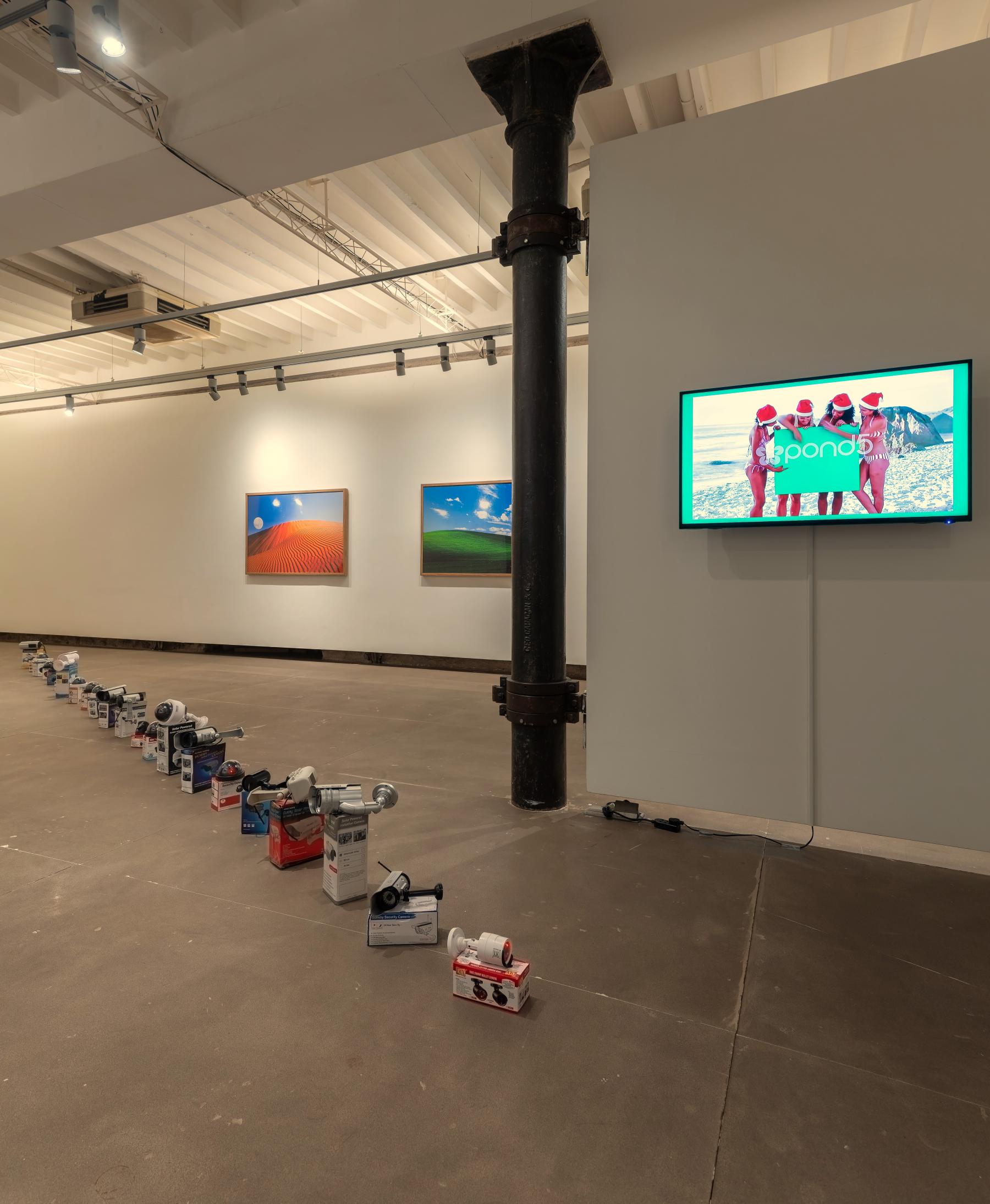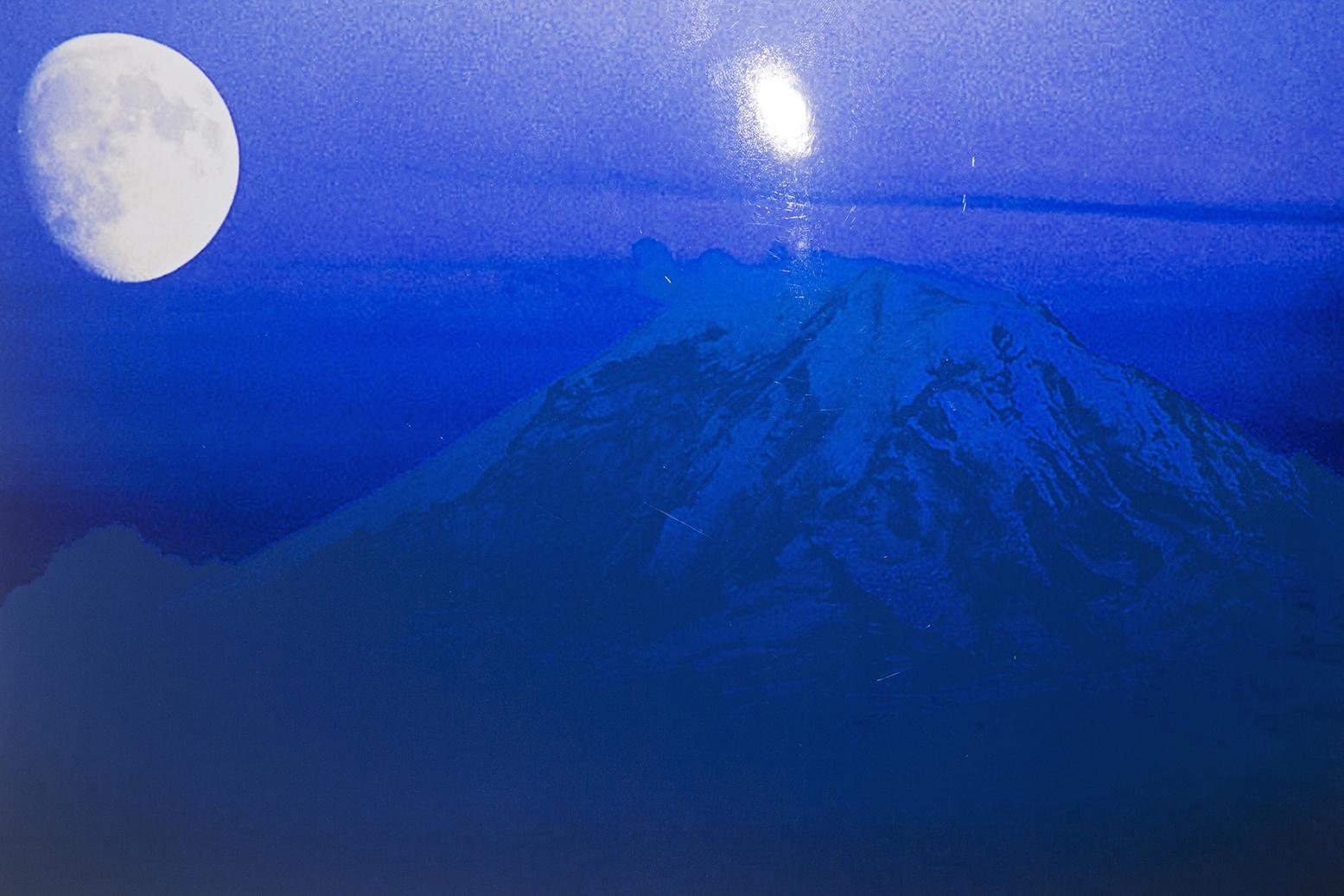Visuality and Blankness: On Nihaal Faizal’s Red Curtains and Green Screens
For many millennials growing up in the 1990s and early 2000s, interactions with technology were often a rare luxury. Without easy access to computers and internet connections at home, it was the ubiquitous cyber cafes across the urban milieu that provided the promise of a wider world from an internet browser. For Rs. 10 per hour, one could dive into the expanse of the World Wide Web. Walking into Nihaal Faizal’s solo exhibition red curtains opening at Chatterjee & Lal in 2023 takes one back to nostalgic memories of late afternoons spent in cyber cafes. One is immediately greeted by the familiarity of the landscape photographs that hang on the walls of the gallery—sandy deserts set against a clear blue sky, golden-yellow foliage underneath an autumn haze, the ancient structure of Stonehenge, a glistening white moon shining brightly on a snowy hill. Windows XP and its multi-hued wallpapers are the base upon which Faizal builds his photographic series Landscape Photographs (2014).

Autumn. One in a set of seven photographs in the series Landscape Photographs (2014).
Interrogating the act of transformation in the source images from photographers across the world, which were digitised and cropped to fit desktop computers, Faizal picks particular wallpapers, prints them at a local photo studio and then photographs these prints. It is this intervention that points us to the various levels of renewal that these photographic images and other stock images undergo every day in a mediatised world. Chinar Shah, who has penned the curatorial essay for Faizal’s debut solo exhibition at Chatterjee & Lal, best describes this act as circular photographic movement, where images are constantly produced and reproduced “from the personal realm to the public domain, from print to screen, and back again.”

Installation view of Dummy (2022).
Faizal further unravels the concept of the stock image, which exists primarily as a generic visual cue, requiring the viewer’s intervention in contextualising and bringing it into existence through acts of meaning-making. One of the works in the exhibition, titled red curtains opening (2014), portrays a compilation of red theatre curtains opening to reveal something, while a TV screen across the room plays four sexy girls hold a green screen at the beach (2014), showing footage of four young women holding a blank board with which they interact over the course of the video. Both of these works play with the concept of the stock image, found across websites like Shutterstock, where the videos themselves lack an intrinsic climactic value; instead, they function as empty expanses, waiting to be filled with meaning and interpretation.
.png)
A screengrab from the video ‘red curtains opening’ (2014).
In both cases, while one may be oblivious to the photographer/videographer who generates the image, the overlaying watermarks are a constant reminder of the commercial nature of these images. Its presence also marks the act of disappearance tied to the monetary payment required for a licence to use the respective photos/videos. In Faizal’s re-appropriation of these stock videos, it is the idea of the supposed emptiness of the green or black screen and the various infinite interpretations it renders possible that ultimately matters.
If Faizal’s interest in the photographic image and the wide expansive potential it holds is a commentary on the production and circulation of images in digital marketplaces, he also challenges the notion of visuality in Dummy (2022). Installed diagonally across the width of the room, a set of cardboard boxes and CCTV cameras peek at the audience, some of them emitting a red glare from time to time. A closer look reveals that these are not real CCTV cameras promising 24x7 surveillance but rather dummy versions—mass-produced and cheaply available—that offer the same promise, except for the lack of recording footage and their functionality when it comes to surveillance. In their act of faking surveillance, the dummies operate in exactly the opposite manner as the stock images. Despite outwardly embodying the act of image-making, they are, after all, devices that lack visuality and open to a blank void of nothingness.
.png)
Installation view of Dummy (2022).
In a documentary-style interrogation of the photographic medium as it operates in an increasingly mediatised world, Faizal’s conceptual artworks emphasise the idea of photographic movement that now surrounds our lives, both physically and in the digital realm. Shah, in her accompanying essay, offers a unique perspective on looking at images produced, circulated and repurposed on loop. According to Shah, there are no longer stable, tidy entities within which the camera, its subject and the resultant image can be boxed. Instead, she states, “We have arrived at a moment where they have all folded in.” Embodying the nostalgia of surfing the web on shared public systems across local cyber cafes, Nihaal Faizal’s conceptual interventions present several questions on the ways in which the photographic image and its visual meaning have travelled across time in the not-so-distant past and the potential promise that blankness and representational visuality hold in the future.

Ascent. One in a set of seven photographs in the series Landscape Photographs (2014).
To read more about Faizal’s practice, revisit Samira Bose’s review of Faizal’s solo show Special FX and Anisha Baid’s reflections on his series Landscape Photographs and Old Indian Photos. Faizal has also contributed to ASAP | art’s Fiction section, you can read his poems here.
All works by Nihaal Faizal. Images courtesy of the artist and Chatterjee & Lal.




